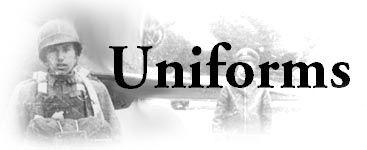
MARK BANDO'S WEBSITE
A Note about Airborne Collecting Since 1997-BUYER BEWARE!
It all started in 1997, when the film 'Saving Private Ryan' came out-until then, original US WW2 items were fairly easy to find and reasonably priced. When everyone and their brother started collecting, the supply of original items could not meet the demand, so many unprincipled dealers began artificially aging fake items like insignia and crickets, making and selling fake items, inventing fake provenance stories etc, because the prices and profits were so high that they could not resist the temptation to cash-in on it. Many of the dealers who are doing this have a pretty detailed knowledge of original stuff, so they can make fakes and stories-up that are good enough to fool the vast majority of collectors. Also, wishful thinking on the part of new collectors who think that paying a high price equals a guarantee of originality has played into the hands of the fakers.
So there you have it in a nutshell-this all happened in recent memory. The value of my WW2 US Airborne collection of uniforms and insignia which started in 1970, suddenly tripled due to the SPR syndrome. Band of Brothers just made things more expensive. Although my holdings gained in value, I still long for the old days, when sale items were usually what they were represented to be and prices were still sane. MOST of the US WW2 101st Airborne uniforms like Ike jackets and officer blouses being offered on E Bay and other public markets, are FAKE. What I mean is that they are 'Hump Jobs', put together using real components like stripped Ike jackets or officer blouses, adding original patches, rank insignia and ribbons, and with a bit of knowledge. This is one reason why I WON'T supply unit rosters to people who request them almost weekly on my forum. Having company and regiment affiliation info, ranks, names and serial numbers, is a goldmine for the hump job artists who need fake but fact-based provenance to attach to their creations, to add that last convincing touch of supposed originality.
This page offers examples of unquestionably original uniforms acquired directly from vets or their families BEFORE the insane prices started-up. My purpose in posting these is to inform collectors of what real stuff looks like (see also Insignia, Equipment, and Souvenirs pages), not to gloat about what I've got. However, the sad truth is, that a skilled hump job, using original parts, looks just the same as an original dress uniform. Add a laundry number and a vet's name and unit, and you've created a piece which is going to be difficult or impossible to debunk. So know your source and ASSUME everything else offered on the market is fake. Paranoia is a virtue in WW2 collecting. Direct vet sources or their families is about the only way any more, to know what you are buying is
what it appears to be.
Just remember when buying from many dealers and most public auctions like E Bay- Buyer Beware!!!!! WW2 Airborne collecting has become a MINEFIELD, every bit as dangerous as collecting WW2 SS artifacts or anything else of high monetary value.
JUMPSUIT M42
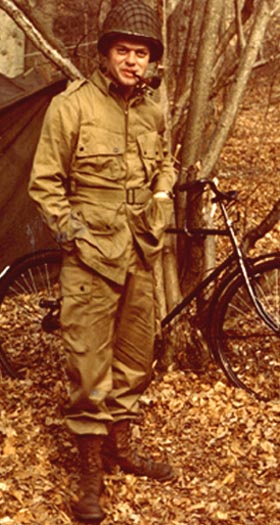 The classic American paratrooper uniform of WW2 was the M42 jumpsuit. Designed by LTC William P.Yarborough, they featured characteristic slanted belows pockets and flaps secured by two snaps on each flap, Wear began in 1942 and ended some time in 1944. The 101st M42 suits were turned-in after Normandy, to be replaced by green M43 combat suits for the duration of WW2. The First Airborne Task Force used them in Operation Dragoon in August, 1944, and the 504 PIR (82nd Airborne) jumped into Holland wearing them in September, 1944. That was probably the last organizational wear of M42's in combat in WW2. Some troopers hid a set in the bottom of their barracks bag when the recall was done. Such suits began to re appear on a spotty basis later in the war. In this 1944 photo, Fred Baynes of 2/501 poses in an M42 suit at Lady Craven's Estate at Hamstead Marshall, near Newbury, Berkshire, England. The M34 pyramidal tent and English bicycle were characteristic of the times. Vintage 44 Kodachrome color slide c/o F. Baynes.
The classic American paratrooper uniform of WW2 was the M42 jumpsuit. Designed by LTC William P.Yarborough, they featured characteristic slanted belows pockets and flaps secured by two snaps on each flap, Wear began in 1942 and ended some time in 1944. The 101st M42 suits were turned-in after Normandy, to be replaced by green M43 combat suits for the duration of WW2. The First Airborne Task Force used them in Operation Dragoon in August, 1944, and the 504 PIR (82nd Airborne) jumped into Holland wearing them in September, 1944. That was probably the last organizational wear of M42's in combat in WW2. Some troopers hid a set in the bottom of their barracks bag when the recall was done. Such suits began to re appear on a spotty basis later in the war. In this 1944 photo, Fred Baynes of 2/501 poses in an M42 suit at Lady Craven's Estate at Hamstead Marshall, near Newbury, Berkshire, England. The M34 pyramidal tent and English bicycle were characteristic of the times. Vintage 44 Kodachrome color slide c/o F. Baynes.
Cecil Simmons' Normandy Jumpsuit
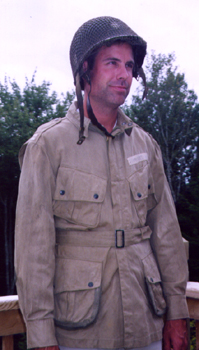
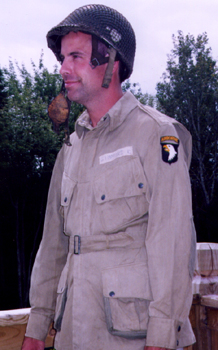 These photos show the M42 rigger-modified and gas impregnated jump jacket worn in Normandy by Captain Cecil L. Simmons C.O. of H/502 PIR. You'll note the drastically faded color, probably a result of trying to cook out the CC-2 in a Calvados pot in France.
These photos show the M42 rigger-modified and gas impregnated jump jacket worn in Normandy by Captain Cecil L. Simmons C.O. of H/502 PIR. You'll note the drastically faded color, probably a result of trying to cook out the CC-2 in a Calvados pot in France.
When I first acquired the suit in 1989, the odor of the CC-2 was VERY strong, but has since diminished, due to airing out on a mannequin. The original period-applied SSI on the left shoulder, is a Type 5 with white tongue.
The helmet being worn is Simmons' later war fixed-bale helmet with stencils and rank marked for when he was a LTC and C.O. of third Bn. 502. He followed Cole and Stopka in that job after they were KIA, and he was the only C.O. of 3/502 to survive WW2.
My 'model' for this 2004 photo is Brian Rissmiller, one of Candace's relatives.
King's Commandos(?)
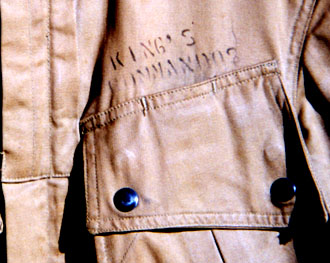 On Monday, 30 October, 2000, this reinforced M42 jacket came out of the proverbial 'woodwork'. The widow of an I/506th Sergeant
had kept it in a basement closet since 1952.
On Monday, 30 October, 2000, this reinforced M42 jacket came out of the proverbial 'woodwork'. The widow of an I/506th Sergeant
had kept it in a basement closet since 1952.
Stenciled above the left chest pocket are the words:"King's Commandos" Inside the rear collar of this jacket is the partial ASN: J1685. Also the hand-printed name JACKSON. With a bit of research, I discovered that this goes with Pfc G.F. Jackson of G/506th. Written in blue ink vertically along the inside center back seam, is the name 'Boggs'. Pfc John Boggs was in I/506th but was KIA in Normandy. Although this jacket is reinforced, it is not impregnated with CC-2 and was most likely not worn in Normandy. My theory is that Jackson of 'G' company was the first owner, then Boggs got ahold of the jacket, then after Boggs' death, a buddy in 'I' co., (from whose widow I obtained the jacket) brought it home.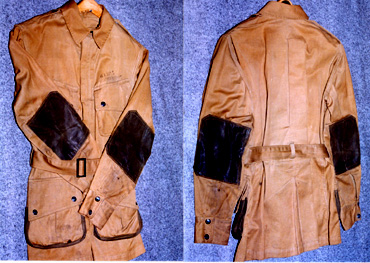 About the jacket: Despite at least 3 owners, this jacket has probably never been washed. The quartermaster/manufacturer's label is intact and quite legible in the lower right pocket and
indicates that it is a 36R, and was made by the 'Manistee Garment Co.' on a contract of Aug.9, 1943. My other reinforced jackets are all-washed-out to varying degrees, but the reinforcement on this jacket is still dark and stiff. Feeling it
around the edge of the lower pockets reminds me of the brand-new repops made by 'WW2 Impressions'. The research goes on, to solve the question of 'King's Commandos'. I already phoned Lt John W. King of HQ/3 506th, but his wife informs that he passed away on 14 February of 2001. Furthermore, that he was 3rd Bn S-4 (supply) officer. Fred Bahlau, former supply sgt of H/506th opines that after he left the job of H/506 supply sgt(Bloody Gulch), to become 1st Sgt, the other 3rd Bn supply sgts continued working under Lt J.W. King. At that time, the four 3rd Bn supply sgts probably all applied the 'King's Commandos' stencil as a sort of joke. This is possible, as the man who brought the jacket home was a later-war supply sgt for 'I' company.
About the jacket: Despite at least 3 owners, this jacket has probably never been washed. The quartermaster/manufacturer's label is intact and quite legible in the lower right pocket and
indicates that it is a 36R, and was made by the 'Manistee Garment Co.' on a contract of Aug.9, 1943. My other reinforced jackets are all-washed-out to varying degrees, but the reinforcement on this jacket is still dark and stiff. Feeling it
around the edge of the lower pockets reminds me of the brand-new repops made by 'WW2 Impressions'. The research goes on, to solve the question of 'King's Commandos'. I already phoned Lt John W. King of HQ/3 506th, but his wife informs that he passed away on 14 February of 2001. Furthermore, that he was 3rd Bn S-4 (supply) officer. Fred Bahlau, former supply sgt of H/506th opines that after he left the job of H/506 supply sgt(Bloody Gulch), to become 1st Sgt, the other 3rd Bn supply sgts continued working under Lt J.W. King. At that time, the four 3rd Bn supply sgts probably all applied the 'King's Commandos' stencil as a sort of joke. This is possible, as the man who brought the jacket home was a later-war supply sgt for 'I' company.
Rigger-Modified M42 Trousers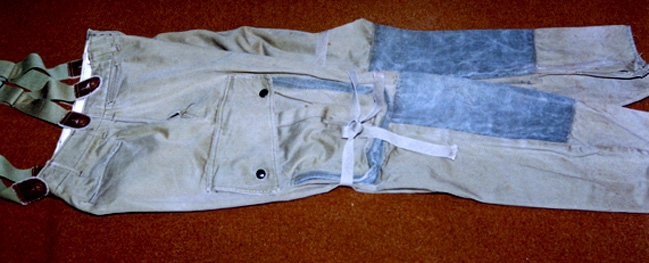 For a limited time period in the ETO, Airborne Riggers modified M42 jump trousers by adding a strip of treated canvas to the edges of both cargo pockets. They also applied knee patches of the same material,
and attached tie down tapes of 3/4" khaki web material to the inseam of each thigh. The tapes could be wrapped around each cargo pocket and tied, as shown to help secure the pocket's contents.
For a limited time period in the ETO, Airborne Riggers modified M42 jump trousers by adding a strip of treated canvas to the edges of both cargo pockets. They also applied knee patches of the same material,
and attached tie down tapes of 3/4" khaki web material to the inseam of each thigh. The tapes could be wrapped around each cargo pocket and tied, as shown to help secure the pocket's contents.
For the Normandy drop, such reinforced garmets were also soaked with CC-2 to resist poison gas. The pair illustrated was not worn in Normandy, but a few machine washings have faded the reinforcing canvas from green to a
characteristic slate gray color. If it makes any difference, this pair belonged to a member of the 506th PIR.
4 Pocket Blouse
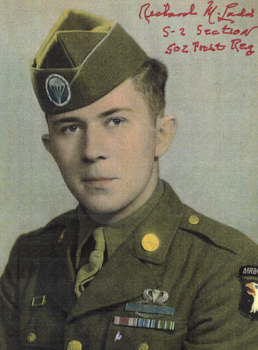 This studio portrait of Dick Ladd H&H S-2, 502 PIR, was made in England after the Normandy campaign. Contrary to usual practice, Ladd wears his Para Infantry cap patch on the right side of his cap, which was usually done by officers. Members of the 502 were the last to yield to wearing the new para glide cap patch, which was finally forced on them in mid 1945. He has been decorated with the Presidential Unit Citation (blue ribbon in gold frame on right chest), as well as the Combat Infantryman's Badge. The four pocket olive-brown blouse was used for dress and walking-out until the Eisenhower type, 2 pocket jacket replaced it in early 1945. Note the straight pocket flaps on unpleated chest pockets. Ladd wears light blue infantry piping on his EM type overseas cap, and a Type 1 eagle patch on his left shoulder. photo courtesy Dick Ladd.
This studio portrait of Dick Ladd H&H S-2, 502 PIR, was made in England after the Normandy campaign. Contrary to usual practice, Ladd wears his Para Infantry cap patch on the right side of his cap, which was usually done by officers. Members of the 502 were the last to yield to wearing the new para glide cap patch, which was finally forced on them in mid 1945. He has been decorated with the Presidential Unit Citation (blue ribbon in gold frame on right chest), as well as the Combat Infantryman's Badge. The four pocket olive-brown blouse was used for dress and walking-out until the Eisenhower type, 2 pocket jacket replaced it in early 1945. Note the straight pocket flaps on unpleated chest pockets. Ladd wears light blue infantry piping on his EM type overseas cap, and a Type 1 eagle patch on his left shoulder. photo courtesy Dick Ladd.
M42 Suits and Combat Boots
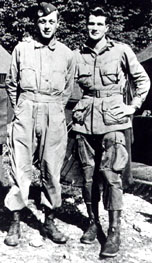
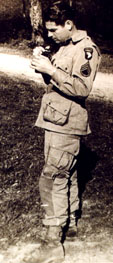 There has been a lot of discussion on the TT Forum about whether M42s were ever worn with combat boots, and also if M42s were worn late in the war (1945 era). The photo above left shows Captain Jack Thornton (in coveralls), with 1st Sgt Bezich (3/501),in England before Market Garden. During this awkward period, jump boots had been recalled and M43's had not yet been issued, resulting in the ugly mix of M42's and combat boots.
There has been a lot of discussion on the TT Forum about whether M42s were ever worn with combat boots, and also if M42s were worn late in the war (1945 era). The photo above left shows Captain Jack Thornton (in coveralls), with 1st Sgt Bezich (3/501),in England before Market Garden. During this awkward period, jump boots had been recalled and M43's had not yet been issued, resulting in the ugly mix of M42's and combat boots.
Sgt Burnside of 2/502 was photographed (upper right), at Ruhpolding, Germany in May, 1945, wearing his old reinforced jumpsuit with combat boots. This gives evidence that some nice M42 suits were still being worn near VE-Day, including some rigger-modified suits.
Wearing M42s in 1945
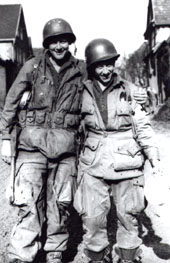
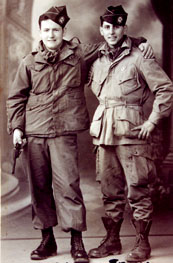 Here's a pair of 502 men(above left), in Alsace (Feb.45) with one still wearing M42s as an outer garment. c/o Len Swartz
Here's a pair of 502 men(above left), in Alsace (Feb.45) with one still wearing M42s as an outer garment. c/o Len Swartz
The studio portrait (upper right) shows 2 members of the 506th at Mourmelon after the Bulge. Les Hashey (l) wears M43's and is armed with a non regulation revolver. T. Rubino (r) is wearing a M42 jumpsuit. c/o T. Rubino
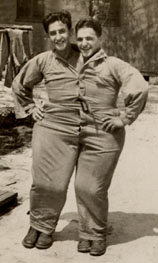 One piece HBT coveralls were among the paratroopers'(mainly stateside) wardrobe and occasionally were even worn on practice jumps. HBT coveralls were also popular with mechanics and Armored vehicle crews. The set depicted above was a slightly large size, as evidenced by the way two 125lb troopers were able to squeeze into it at the same time. At left is Manuel "The Greek" Dandis, and at right, Denver Madden (KIA Holland), both of the 2/501's LMG platoon. c/o G. Derber.
One piece HBT coveralls were among the paratroopers'(mainly stateside) wardrobe and occasionally were even worn on practice jumps. HBT coveralls were also popular with mechanics and Armored vehicle crews. The set depicted above was a slightly large size, as evidenced by the way two 125lb troopers were able to squeeze into it at the same time. At left is Manuel "The Greek" Dandis, and at right, Denver Madden (KIA Holland), both of the 2/501's LMG platoon. c/o G. Derber.
MARK BANDO'S WEBSITE
COMBAT JUMPSUIT, M43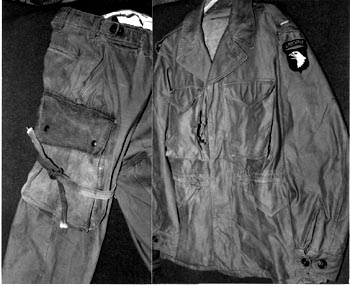 In mid 1944 (after the 101st returned from Normandy), the entire U.S. Army was undergoing a reform to eliminate all "non-standard" uniforms. The M42 jumpsuits and paratrooper boots were recalled. Paratroopers were issued green M43 combat suits and combat boots with rawhide bodies and a flap secured around the ankle with two straps. Much protest was raised over these affronts, and the jump boots were eventually restored. However, M42 suits became a permanent thing of the past. To make the best of the situation, parachute riggers began converting the plain M43 combat trousers to jump trousers, by adding a large canvas cargo pocket to each leg as well as tie-down straps, to secure the load in each pocket. This
particular suit was retained by Lt Jim Loftus of F/501 because of its souvenir value. During the battle of Bastogne, near Neffe, Belgium, Loftus was running under mortar fire, when a spinning fragment tore into his right chest pocket at an angle. It spun into the pocket, ripped up a pack of cigarettes, came through the inner lining, and dropped out before it could do any damage to Lofty.
Jim jumped into a foxhole and didn't realize what had happened until he reached into his chest pocket for a cigarette. At that time, he found only torn paper, loose tobacco, and discovered a jagged hole on the edge of his pocket. The jacket has a Type 1 U.S. made eagle patch and 1st Lt bars executed in white thread, in individual stitches by Lofty, on each shoulder. Below is a
1982 photo showing Jim Loftus wearing his shrapnel torn jacket.
In mid 1944 (after the 101st returned from Normandy), the entire U.S. Army was undergoing a reform to eliminate all "non-standard" uniforms. The M42 jumpsuits and paratrooper boots were recalled. Paratroopers were issued green M43 combat suits and combat boots with rawhide bodies and a flap secured around the ankle with two straps. Much protest was raised over these affronts, and the jump boots were eventually restored. However, M42 suits became a permanent thing of the past. To make the best of the situation, parachute riggers began converting the plain M43 combat trousers to jump trousers, by adding a large canvas cargo pocket to each leg as well as tie-down straps, to secure the load in each pocket. This
particular suit was retained by Lt Jim Loftus of F/501 because of its souvenir value. During the battle of Bastogne, near Neffe, Belgium, Loftus was running under mortar fire, when a spinning fragment tore into his right chest pocket at an angle. It spun into the pocket, ripped up a pack of cigarettes, came through the inner lining, and dropped out before it could do any damage to Lofty.
Jim jumped into a foxhole and didn't realize what had happened until he reached into his chest pocket for a cigarette. At that time, he found only torn paper, loose tobacco, and discovered a jagged hole on the edge of his pocket. The jacket has a Type 1 U.S. made eagle patch and 1st Lt bars executed in white thread, in individual stitches by Lofty, on each shoulder. Below is a
1982 photo showing Jim Loftus wearing his shrapnel torn jacket.
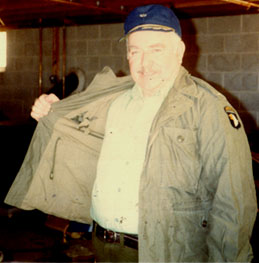
Rigger Modified M43 Combat Trousers
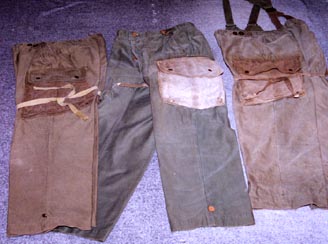 Some observations about the 3 pair of combat jump trousers shown above. These green pants were introduced for wear in the 101st Airborne before
September, 1944. They were worn in Holland, at Bastogne, and for the duration of WW2, replacing the earlier M42's. A special canvas, chemically-treated to be water-resistant (the same type used to reinforce pockets, knees and elbows on M42 suits), was made into cargo pockets by the Riggers and sewn onto each pant leg of the M43 combat trousers. Various government contractors manufactured the pants themselves. Of the above, the pair at left was issued to a 501st PIR medic. The tie-down straps, also added by Riggers are 3/4" tan web tape, the same as used on M42 reinforced trousers. I suspect that only the earliest modified M43's used the same web tape for awhile, then the Riggers switched to using long strips of folded and sewn canvas as tie-downs. These are of the same material as the pockets. The pair at right, from Lt Loftus, also of 501, have the canvas tie-downs and were probably modified somewhat later than the pair at left. The pair at center, from a 326th Engineer Bn officer, are of interest because although the cargo pockets have faded almost to white, the pants themselves are still a rich green color. The green dye used on the treated canvas always faded at a faster rate than the M43 trousers themselves, but note how these trousers are greener than the other 2 pair, despite the fact that they have been washed more times, judging from the amount of fading to the pockets. The center pair had canvas tie-downs, which as often happened, were cut off by the original owner. Some troopers considered the tie-downs an unnecessary hindrance. The center pair also features small pale brown plastic buttons, similar to those seen on many M42 trousers. A finite number of M43 trousers were Rigger-modified and of those which survived WW2, many were worn out by veterans on postwar hunting and fishing trips. Today, surviving examples are about as rare as reinforced M42 trousers. Regarding the green canvas material used to manufacture the pockets, Brooks Bush says: "I think it is the same material as the M42 reinforcement. I found that canvas once-it was an aircraft canopy cover. The snaps, stitching, and thread were the same as the pockets. I think it was a canvas supplied to the Air Corps and then to the Airborne Riggers, although they did use other canvas similar to shelter half."
Some observations about the 3 pair of combat jump trousers shown above. These green pants were introduced for wear in the 101st Airborne before
September, 1944. They were worn in Holland, at Bastogne, and for the duration of WW2, replacing the earlier M42's. A special canvas, chemically-treated to be water-resistant (the same type used to reinforce pockets, knees and elbows on M42 suits), was made into cargo pockets by the Riggers and sewn onto each pant leg of the M43 combat trousers. Various government contractors manufactured the pants themselves. Of the above, the pair at left was issued to a 501st PIR medic. The tie-down straps, also added by Riggers are 3/4" tan web tape, the same as used on M42 reinforced trousers. I suspect that only the earliest modified M43's used the same web tape for awhile, then the Riggers switched to using long strips of folded and sewn canvas as tie-downs. These are of the same material as the pockets. The pair at right, from Lt Loftus, also of 501, have the canvas tie-downs and were probably modified somewhat later than the pair at left. The pair at center, from a 326th Engineer Bn officer, are of interest because although the cargo pockets have faded almost to white, the pants themselves are still a rich green color. The green dye used on the treated canvas always faded at a faster rate than the M43 trousers themselves, but note how these trousers are greener than the other 2 pair, despite the fact that they have been washed more times, judging from the amount of fading to the pockets. The center pair had canvas tie-downs, which as often happened, were cut off by the original owner. Some troopers considered the tie-downs an unnecessary hindrance. The center pair also features small pale brown plastic buttons, similar to those seen on many M42 trousers. A finite number of M43 trousers were Rigger-modified and of those which survived WW2, many were worn out by veterans on postwar hunting and fishing trips. Today, surviving examples are about as rare as reinforced M42 trousers. Regarding the green canvas material used to manufacture the pockets, Brooks Bush says: "I think it is the same material as the M42 reinforcement. I found that canvas once-it was an aircraft canopy cover. The snaps, stitching, and thread were the same as the pockets. I think it was a canvas supplied to the Air Corps and then to the Airborne Riggers, although they did use other canvas similar to shelter half."
DETAIL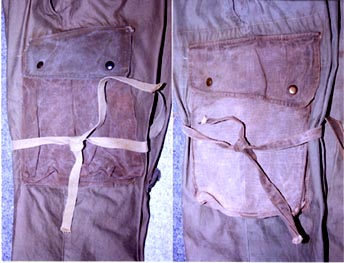 The above shot shows a single leg cargo pocket on each of 2 pair of Rigger-modified M43 pants. The earlier (web tape) tie-downs are visible on the pair at left. The pair at right has the more common folded and sewn strips of canvas for tie-downs. These pants are so rare that I don't know of any reference book which has ever depicted an authentic pair. The examples worn in the Brit book 'The WW2 G.I. in Color Photographs' are bogus; the pockets are made of the wrong material. I also didn't see a single pair of these pants in the Market-Garden museum near Best, Holland in 1998.
A reliable source tells me those shown in the recent Schiffer book on Airborne collectibles were actually modified about ten years ago by my friend Brooks Bush. Brooks is a talented guy, but he never mis-represents his work. In fact, he has severely limited production of REPRO M43 pants and fixed bale Airborne helmet straps to avoid having his work misrepresented by others. I have deliberately ommitted photos showing how the straps are affixed to the legs, but at least the re enactors can see what type of material was used for the tie-downs.
The above shot shows a single leg cargo pocket on each of 2 pair of Rigger-modified M43 pants. The earlier (web tape) tie-downs are visible on the pair at left. The pair at right has the more common folded and sewn strips of canvas for tie-downs. These pants are so rare that I don't know of any reference book which has ever depicted an authentic pair. The examples worn in the Brit book 'The WW2 G.I. in Color Photographs' are bogus; the pockets are made of the wrong material. I also didn't see a single pair of these pants in the Market-Garden museum near Best, Holland in 1998.
A reliable source tells me those shown in the recent Schiffer book on Airborne collectibles were actually modified about ten years ago by my friend Brooks Bush. Brooks is a talented guy, but he never mis-represents his work. In fact, he has severely limited production of REPRO M43 pants and fixed bale Airborne helmet straps to avoid having his work misrepresented by others. I have deliberately ommitted photos showing how the straps are affixed to the legs, but at least the re enactors can see what type of material was used for the tie-downs.
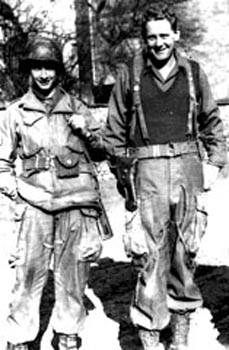
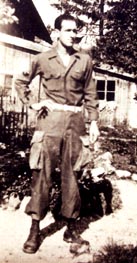 Above left, Fred Patheiger and Len Swartz of H&H 502 wearing Rigger modified M43s in Alsace in 1945. The canvas pockets show fading and one can clearly see where Fred chopped-off most of his canvas leg tie-downs. The photo at right shows T-4 John Seney of HQ/2 502, in Austria in 1945. Note the color contrast caused by fading to his canvas pockets-the result of a few washings. John had also removed the tie-down straps from his trouser legs. photo courtesy of the late Len Swartz and Mrs Sarah Seney.
Above left, Fred Patheiger and Len Swartz of H&H 502 wearing Rigger modified M43s in Alsace in 1945. The canvas pockets show fading and one can clearly see where Fred chopped-off most of his canvas leg tie-downs. The photo at right shows T-4 John Seney of HQ/2 502, in Austria in 1945. Note the color contrast caused by fading to his canvas pockets-the result of a few washings. John had also removed the tie-down straps from his trouser legs. photo courtesy of the late Len Swartz and Mrs Sarah Seney.





















